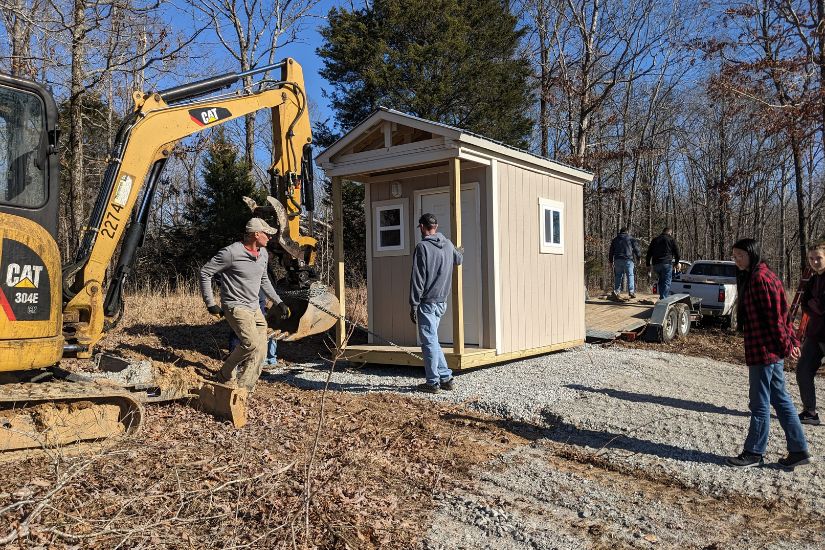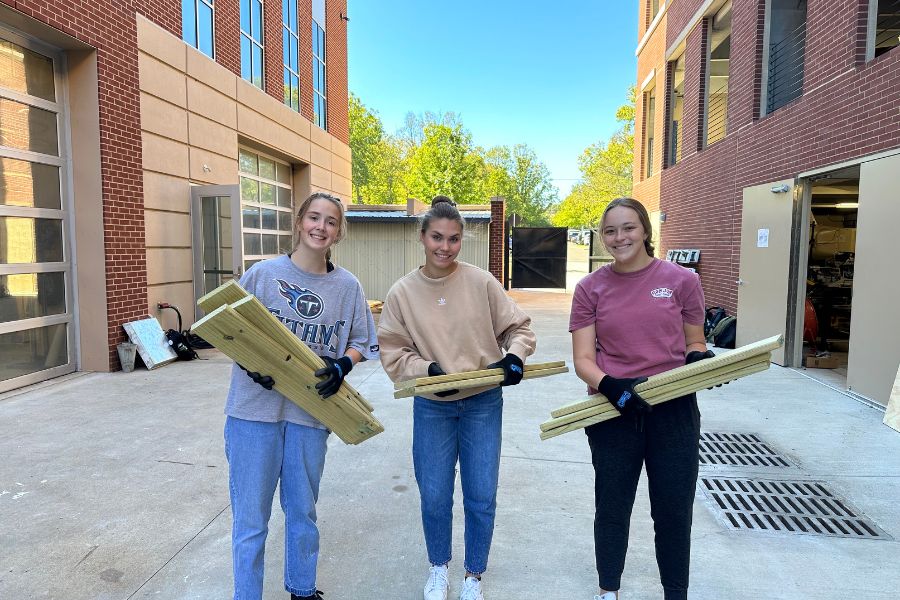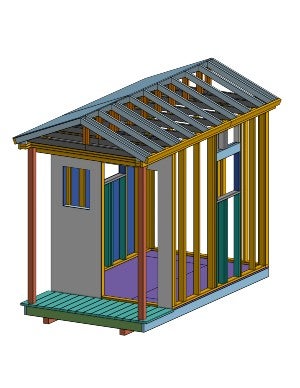Microhome built by students will have a macro impact
Freshman engineering students and faculty build microhome destined for Humphreys County ministry.
Janel Shoun-Smith | 615.966.7078 |

A group of students and faculty came out in January to deliver the completed microhome to Second Chance Ministries in Humphreys County.
View WSMV-NBC coverage of this project.
Every fall brings a new group of freshmen in the Introduction to Engineering course at Lipscomb University, but at Lipscomb, the freshmen do a lot more in their very first course than simply learn the fundamentals of engineering design.
This fall the 14 students in one of the mechanical engineering sections of the intro course also built a microhome, a tiny 12-foot by 7-foot structure that is bound for Hurricane Mills, Tennessee, to be used by Second Chance Ministries to temporarily house displaced people or those in short-term crisis.
The students spent their weekly lab time throughout the semester constructing the tiny home that can be powered by either the utility grid or by solar power. Though tiny, the microhome project is the perfect size for new engineering majors to get hands-on experience applying theory on a real-world scale, said Dr. David Elrod, dean of the Raymond B. Jones College of Engineering, who has been rolling up his sleeves to work with the students throughout the semester.


The completed home was delivered to Humphreys County, Tennessee, where a 2021 destroyed most of Waverly's public housing.
The project gave students the opportunity to use trigonometry to calculate the angles and dimensions needed for trusses, to learn practical skills like how to “build square,” to make decisions about what materials to use where (such as plywood or metal gussets) and to take one project from concept to completion themselves, Elrod said.
All of the materials needed for the microhome were donated by Thomas Lumber Company in Clarksville, the family business of Brandon Thomas (’15, MBA ’17), a mechanical engineering graduate of the college.
The microhome project is an example of the type of service-oriented, real-world project that is included in all its Intro to Engineering sections to teach students about the engineering design process, said Dr. Kirsten Dodson, associate professor and instructor of the course.

Her mechanical engineering section of the course required the students to work in teams to adapt the standard design of the microhome to a particular population. Students adapted the original microhome design for four different vulnerable populations: a mother and her baby, a homeless student, a blind individual and someone who uses a wheelchair.Students visited organizations that serve each of these populations to learn first-hand about how to adapt the microhome design to best fit the needs of their client, Dodson said.
After seeing the long-term effects of the devastating floods in Waverly in August 2021, Shirley James, founder and President of Second Chance Ministries, realized that her small operation providing budgeting assistance, navigation of available social services and temporary housing in hotels for those in crisis, needed to step up its game. In times of disaster, her ministry based in Humphreys County needed more room and board for displaced individuals, she said.

She became aware of Lipscomb’s College of Engineering through the Green Street Church of Christ, which operates Sanctuary, a tiny home village near downtown Nashville for people experiencing homelessness. The church provides a common kitchen and bath for the residents, who live in a group of tiny homes that have been built over the years by various organizations.
Lipscomb’s College of Engineering faculty and students installed solar power in Green Street’s tiny homes in 2021 and built a tent platform onsite in 2022.
After learning about Lipscomb’s involvement with the Green Street project, James contacted the college about building a tiny home for the use of Second Chance. The ministry is already working on building two 720-square-foot cabins that will include kitchens and baths and will be intended to house families.
A small church in Hurricane Mills was donated to the ministry and is now being renovated to become an eight-bedroom facility to house women and their daughters. The microhome built by Lipscomb will be used to temporarily house men, James said.
Over the years, Second Chance has provided temporary shelter to people from age 19 to 80, said James. Until just a few months ago, Second Chance was still housing a few people who had been displaced by the 2021 floods in hotels, an expensive way to provide the needed shelter, she said.

3D CAD model of the microhome by Thomas Joubran
“The floods made a big impact on our small community,” said James. “The need was great, and we weren’t ready. That was heart wrenching. These homes are going to be a great blessing to us and people in the community.”
Corey Confer, a military veteran who kicked off his college career in engineering this fall, said the microhome build is exactly the kind of project that drew him into engineering.
“When I was deployed overseas, I saw a lot of people who were poverty stricken. The ability to do something about that here is part of why I came to Lipscomb,” said Confer.
Thomas Joubran, another student in the Intro to Engineering lab section, built a 3D CAD model of the microhome in OnShape in addition to his other class assignments. The model was helpful for visualizing adjustments as the design was finalized and could be used as a blueprint for future microhome projects.
In addition to being a good local alternative for students who are not able to participate in international service projects, the microhome also was a great way to introduce students to power tools, something that many come into college knowing little about, said Elrod.
Confer was quick to help younger students, like Kasen Holt of Manchester, Tennessee, learn the ropes with power tools. Holt helped build the trusses and did a lot of measuring, as well as learned from more experienced students how to handle electric tools.
“It was fun to see this come to life in such a hands-on way,” said Holt.

Lipscomb President Candice McQueen came out to say goodbye to the completed microhome on delivery day in January.